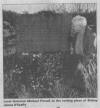A
forgotten graveyard on the edge of town
-

- Volunteers who helped clean up the Old
Graves back in 1998 were Tony Hayden, Colin Mulhall,
- Emmet Mulhall, Tom Mulhall, Tom Mooney,
Laurence Doyle, Robina Mooney and Martin Curran
Thousands of bodies lay there, while hundreds more scatter the perimeter.
No-one has been buried in the Old Graves on the Barrow Track at the edge of
Carlow Town Park in more than 50 years. And many of its inhabitants are now
just faded memories in the minds of old Carlovians.
The graveyard, disused and overgrown, was once the main burial place for
Carlow town.

The last person buried there was in 1956 when a Mrs Ray from St Mary’s Park
was laid to rest. But the oldest fragmented grave stone uncovered at the
cemetery belonged to a man by the surname of Sherlo...? (the remaining letters
in the surname were indecipherable), who passed away in 1718.
His wife and five children were also buried in the same plot before him.
Tragically, on the periphery of the graveyard lie the tiny remains of
hundreds of babies, who died before they were baptised.
“They couldn’t be buried on consecrated ground because they weren’t
baptised, so their parents buried them in the environs of consecrated ground
in the hope that they would go to heaven,” explained local historian Michael
Purcell. “It is the same with St Mary’s and all of the other graveyards
around the country: babies are buried all around the periphery”.
Numerous efforts have been made over the years by locals to maintain the
graveyard. In 1987, for example, the Carlow County Heritage Society spent an
entire summer recording the transcripts on all of the visible gravestones,
and their epic work uncovered a further eight graves.
Further clean-ups in 1998 also uncovered more graves, and parish records
from Carlow Cathedral show that between 1850 and 1950 alone, 2,037 people
were buried at the graveyard.
However, it is believed that thousands more lie there in unmarked graves
since the cemetery was first handed over to the Roman Catholic population of
Carlow town around 1630. “It was given to the people of Carlow during the
reign of King James I,” said Michael. “We reckon the land was granted by the
Earl of Thomond about 1630.”
Before that, Michael said people were buried around the Pollerton Road and
Oak Park area.
Carlow in the 1600s was an incredibly different place to what it is today.
“Around 1650, the population of Carlow town would have been about 3,000 but
it kept increasing from then on,” revealed Michael, who has studied census
returns for the town from that period.
Of those buried in the graveyard, Michael says “a lot would have died from
what was described as ‘a visitation from God,’ meaning someone young simply
passing away.
Other common causes of death for those in Carlow town at the time would have
been cholera, typhus and what was described as “destitution”, which could
have meant anything from dying of the cold to starvation.
 The
only person of note buried there, Michael said, is Bishop James O’Keeffe,
the man responsible for building Carlow College.
The
only person of note buried there, Michael said, is Bishop James O’Keeffe,
the man responsible for building Carlow College.
“He passed away in 1787 and requested that he be buried among the poor.”
Also buried at the cemetery were men executed after the 1798 Rebellion,
including Cpt Pat Kelly from Castle Hill, who was hanged and beheaded. His
head was placed on a spike afterwards. His friend Lt John Berne, a member of
the United Irishmen, was also executed after the rising. As was another man,
Paddy Hackett, the owner of a pub called the Punch and Porter House in
Graiguecullen, who was killed because he bought drink for the United
Irishmen. Survivors of an array of conflicts from the Boer War to the
Crimean and Napoleonic Wars also lie at The Old Graves. A plaque was erected
in 1998 in memory of the men.
The Old Graves, however, can’t be mentioned without uttering the name Tottie
Foley.
“Tottie was an old Carlovian who passed away in 1977. A plaque is erected in
his honour at the corner of John Street; he gave 20 years of his life to the
graves. He went up there at 9am and stayed there until 6pm; he gave his
whole retired life to maintaining that graveyard,” revealed Michael.
He was so dedicated that RTE even made a documentary about him in 1969.
“There is an old story which says that one time in 1965 Tottie’s neighbour
put out a rumour that he had found gold coins up at the graves. The next
week when he went up there, he had about 50 people, all armed with shovels
helping him. He didn’t know the story was put out himself – it was only when
someone eventually asked him where he found the coins that he realised. His
neighbour had only done it to get Tottie some help at the graves.”
These days, the graveyard is maintained twice a year by the Civic Amenity
Trust, with town clerk Michael Brennan describing the graveyard as “very
important, historically”.
The graveyard can still be easily accessed by all and the hope is that it
and its inhabitants will continue to live on in the memory of the people of
Carlow town.
-
-
Corporal Patrick Mulhall of the Royal Dublin
Fusiliers, who was from Bridewell Lane in
Carlow is buried in the Old Graves. He died
on 19 January 1918 from wounds received
during World War I in Gallipoli. His gravestone
is maintained, sand-blasted and the inscription
is renewed by the British War Graves Commission.
-
- Source: The Nationalist 31 January 2012.
p22.